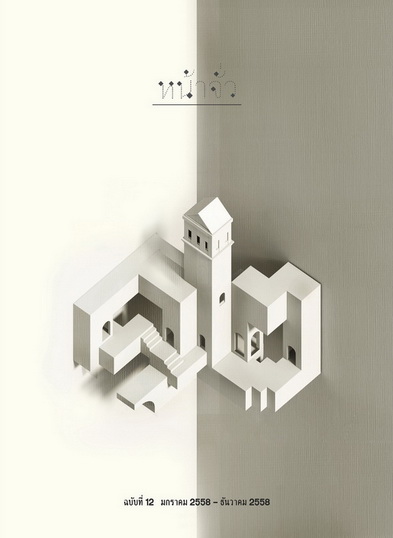การเปลี่ยนแปลงการใช้พื้นที่ศาสนสถานประจำอโรคยาศาลในพื้นที่ภาคตะวันออกเฉียงเหนือ/The Change of Chapel of Arogayasala’s Usage Patterns : A Case Study of Northeastern Thailand
Main Article Content
Abstract
บทคัดย่อ
อโรคยาศาล ถูกสร้างขึ้นในรัชสมัยของพระเจ้าชัยวรมันที่ 7 แห่งเมืองพระนครหลวง อาณาจักรขอมโบราณ มูลเหตุในการสร้างเพื่อใช้เป็นโรงพยาบาลประจำชุมชน พบจำนวน 30 แห่งในภาคตะวันออกเฉียงเหนือของประเทศไทย ปัจจุบันร่องรอยของอโรคยาศาลที่พบนั้นเหลือเพียงส่วนศาสนสถานประจำ อโรคยาศาลที่มีรูปแบบองค์ประกอบของผังการสร้างที่แน่นอนตายตัว รูปแบบสถาปัตยกรรมสะท้อนให้เห็นถึงแนวคิดความเชื่อเกี่ยวกับการรักษาพยาบาล และการขอพรจากเทพเจ้าในพุทธศาสนาแบบมหายานช่วงพุทธศตวรรษที่ 18 ได้อย่างชัดเจน ตัวศาสนสถานประจำอโรคยาศาลสร้างขึ้นด้วยวัสดุที่คงทนถาวร คือหินทรายและศิลาแลง แต่ในส่วนโรงเรือนการรักษาพยาบาลสันนิษฐานว่าสร้างขึ้นด้วยโครงสร้างไม้ ในปัจจุบันจึงไม่ปรากฏหลักฐานให้เห็น
บทความนี้นำเสนอถึงการเปลี่ยนแปลงการใช้พื้นที่ภายในของโบราณสถานศาสนสถานประจำอโรคยาศาล สามารถแบ่งการเปลี่ยนแปลงการใช้ประโยชน์ของพื้นที่ได้เป็น 3 ช่วงเวลาคือ การใช้พื้นที่ในอดีต พบว่ามีการใช้พื้นที่อยู่ 2 ส่วน ส่วนแรกเป็นพื้นที่ด้านความเชื่อ คือส่วนศาสนสถานประจำอโรคยาศาล ใช้เป็นพื้นที่สักการบูชาต่อเทพต่างๆ ที่เกี่ยวข้องกับการรักษาพยาบาล ส่วนที่ 2 คือส่วนรักษาพยาบาล เป็นส่วนที่มีการใช้พื้นที่ด้านนอกตัวศาสนสถาน ส่วนใหญ่มักตั้งอยู่ในพื้นที่ด้านทิศเหนือ โดยขอบเขตของการรักษาพยาบาลจะครอบคลุมไปถึงพื้นที่ชุมชนโดยรอบในระยะที่สามารถเดินทางมาถึงได้โดยสะดวก
การใช้พื้นที่ในช่วงคาบเกี่ยวที่เป็นจุดเปลี่ยนของการเปลี่ยนแปลงการใช้พื้นที่ในช่วงพุทธศตวรรษที่ 21-24 พบว่า มีการตั้งถิ่นฐานใหม่ของกลุ่มชนใหม่ที่อพยพเคลื่อนย้ายมา กลุ่มคนดังกล่าวยังมีความศรัทธาต่อศาสนสถานเดิมที่มีมาก่อนกับบทบาทความเชื่อที่เปลี่ยนไป บางแห่งถูกปรับเปลี่ยนให้เป็นพุทธสถานในคติเถรวาทแทน มีการสร้างวัดหรือสำนักสงฆ์ขึ้นทับซ้อนในพื้นที่ สร้างพระพุทธรูปใหม่ประดิษฐานไว้ภายใน เชื่อว่าพื้นที่นี้เป็นพื้นที่ศักดิ์สิทธิ์ เป็นที่สิ่งสถิตของผีปู่ตาหรือเทวดา จึงไม่มีผู้ใดกล้าเข้าไปใช้พื้นที่เป็นการส่วนตัว สำหรับการใช้พื้นที่ในช่วงเวลาปัจจุบัน มีการประกอบพิธีกรรมภายในศาสนสถานประจำอโรคยาศาลในช่วงวันสำคัญ เช่น การสรงกู่ ซึ่งจัดขึ้นเป็นประจำทุกปี โดยรูปแบบและความหลากหลายของกิจกรรมจะแปรผันไปตามขนาดของชุมชนและผู้จัดงาน โดยทั่วไปประเพณีสรงกู่จะถูกกำหนดขึ้นในช่วงเวลาที่เกี่ยวข้องกับงานบุญสิบสองเดือน โดยถือเอาวันขึ้น 15 ค่ำ เดือน 5 ของทุกปีตามปฏิทินทางจันทรคติเป็นวันที่ใช้ประกอบพิธีกรรม
Abstract
Arogayasalas were built by Jayavarman VII, King of Khmer empire, around 19th Buddhist century. The objective of Arogayasala was to provide space for medical treatment for the community. Around 30 Arogayasalas were discovered in the northeastern region of Thailand. At present, evidence of Arogayasala is only its Chapel with standard elements. Its design represents medical treatment beliefs and religious worship concepts. Chapel of Arogayasala was built by laterite and sandstone. It is presumed that the medical treatment building was wood pavilion construction therefore its evidence is unidentified.
This paper presents the change of Chapel of Arogayasala’s usage patterns by classify the analysis into three sessions. The first session is the usage pattern in the part period. It was found that there were two main areas. The first area was religious area, Chapel of Arogayasala, which had many holy images on the sides. The second area was medical treatment area which was located on the north, outside the enclosure wall. The scope of medical treatment was extended to the surrounding community within a walking distance.
The second session is the usage pattern in the overlapping period around 21st -24th Buddhist century. It was found that there was a new settlement in this area. The new ethnic still had faith in original monastery. The usage patterns of the Chapel of Arogayasals had been changed to Theravada Buddhism monastery. The new temples were built in this area. The new Buddha images were placed inside. People believed that this sacred area was the living place of the ancestral spirits or local gods. Therefore, no one occupied the place of worship for personal usage.
The final session is the usage pattern in the present time. Chapel of Arogayasalas has monument. It has been used for special activities, such as, Srung-Ku ceremony and Worship ceremony, which have been held every year. The number of activities and its format are varied based on to the size of the community and host of the event .The activities is usually held annually on the Waxing (full moon) 15 evening of the 5th month according to the Thai lunar calendar.


